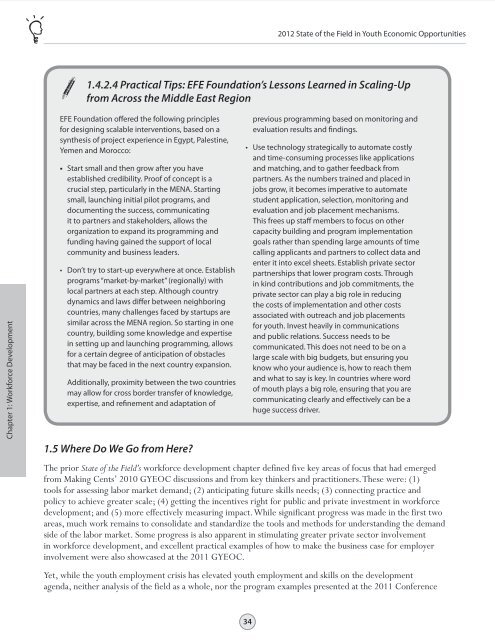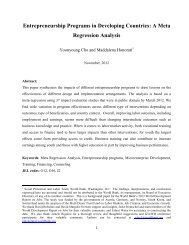STATE OF THE FIELD IN YOUTH ECONOMIC OPPORTUNITIES
STATE OF THE FIELD IN YOUTH ECONOMIC OPPORTUNITIES
STATE OF THE FIELD IN YOUTH ECONOMIC OPPORTUNITIES
You also want an ePaper? Increase the reach of your titles
YUMPU automatically turns print PDFs into web optimized ePapers that Google loves.
Table of Contents<br />
Chapter 1 Chapter 2 Chapter 3 Chapter 4 Chapter 5 Chapter 6 Chapter 7 Chapter 8<br />
Chapter 9<br />
Chapter 10 Chapter 11 Chapter 12 Chapter 13 Chapter 14 Chapter 15 Annexes<br />
2012 State of the Field in Youth Economic Opportunities<br />
Chapter 1: Workforce Development<br />
1.4.2.4 Practical Tips: EFE Foundation’s Lessons Learned in Scaling-Up<br />
from Across the Middle East Region<br />
EFE Foundation offered the following principles<br />
for designing scalable interventions, based on a<br />
synthesis of project experience in Egypt, Palestine,<br />
Yemen and Morocco:<br />
• Start small and then grow after you have<br />
established credibility. Proof of concept is a<br />
crucial step, particularly in the MENA. Starting<br />
small, launching initial pilot programs, and<br />
documenting the success, communicating<br />
it to partners and stakeholders, allows the<br />
organization to expand its programming and<br />
funding having gained the support of local<br />
community and business leaders.<br />
• Don’t try to start-up everywhere at once. Establish<br />
programs “market-by-market” (regionally) with<br />
local partners at each step. Although country<br />
dynamics and laws differ between neighboring<br />
countries, many challenges faced by startups are<br />
similar across the MENA region. So starting in one<br />
country, building some knowledge and expertise<br />
in setting up and launching programming, allows<br />
for a certain degree of anticipation of obstacles<br />
that may be faced in the next country expansion.<br />
Additionally, proximity between the two countries<br />
may allow for cross border transfer of knowledge,<br />
expertise, and refinement and adaptation of<br />
1.5 Where Do We Go from Here<br />
previous programming based on monitoring and<br />
evaluation results and findings.<br />
• Use technology strategically to automate costly<br />
and time-consuming processes like applications<br />
and matching, and to gather feedback from<br />
partners. As the numbers trained and placed in<br />
jobs grow, it becomes imperative to automate<br />
student application, selection, monitoring and<br />
evaluation and job placement mechanisms.<br />
This frees up staff members to focus on other<br />
capacity building and program implementation<br />
goals rather than spending large amounts of time<br />
calling applicants and partners to collect data and<br />
enter it into excel sheets. Establish private sector<br />
partnerships that lower program costs. Through<br />
in kind contributions and job commitments, the<br />
private sector can play a big role in reducing<br />
the costs of implementation and other costs<br />
associated with outreach and job placements<br />
for youth. Invest heavily in communications<br />
and public relations. Success needs to be<br />
communicated. This does not need to be on a<br />
large scale with big budgets, but ensuring you<br />
know who your audience is, how to reach them<br />
and what to say is key. In countries where word<br />
of mouth plays a big role, ensuring that you are<br />
communicating clearly and effectively can be a<br />
huge success driver.<br />
The prior State of the Field’s workforce development chapter defined five key areas of focus that had emerged<br />
from Making Cents’ 2010 GYEOC discussions and from key thinkers and practitioners. These were: (1)<br />
tools for assessing labor market demand; (2) anticipating future skills needs; (3) connecting practice and<br />
policy to achieve greater scale; (4) getting the incentives right for public and private investment in workforce<br />
development; and (5) more effectively measuring impact. While significant progress was made in the first two<br />
areas, much work remains to consolidate and standardize the tools and methods for understanding the demand<br />
side of the labor market. Some progress is also apparent in stimulating greater private sector involvement<br />
in workforce development, and excellent practical examples of how to make the business case for employer<br />
involvement were also showcased at the 2011 GYEOC.<br />
Yet, while the youth employment crisis has elevated youth employment and skills on the development<br />
agenda, neither analysis of the field as a whole, nor the program examples presented at the 2011 Conference<br />
34

















